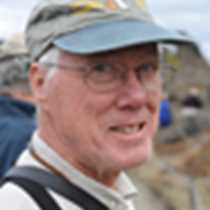Icy Strait / Cross Sound, Southeast Alaska
We spent our day where Icy Strait meets Cross Sound. Here, the water of the Inside Passage of Alaska meets the North Pacific Ocean. To the west is the Gulf of Alaska and, on its far side, Kodiak Island. Twice each day, seawater rushes in through the narrow opening on rising tides and flows out with the falling tides. Each tidal cycle stirs up nutrient-rich bottom water, fueling marine productivity. During spring and summer huge numbers of herring and salmon that have grown to maturity in the open ocean return to Southeast Alaska to spawn, passing through this entrance with the incoming tides.
These factors make this a very rich area for wildlife. We could see this from the abundance of seabirds as we approached. Captain Kay took the National Geographic Sea Bird into Cross Sound. Way off in the distance, Pete Pederson spotted the distinctive erect dorsal fins of killer whales (aka orca.) These whales come in two forms in Southeast Alaska. Those that we call Residents feed on fish, especially salmon; others, called Transients, feed on marine mammals. The differences between the forms are subtle, but detectable. Most important, the whales recognize the difference and do not interbreed. The two forms behave as separate species. Our whales were of the less-common mammal-eating sort. These swim in smaller groups than the Residents and spend more of their time moving stealthily, searching for their prey. Skillful ship-handling and cooperative whales combined to give us superb views of these iconic symbols of wildness ... and all of this before breakfast! And during breakfast as well, as three killer whales swam by just outside the dining room window.
We left the ship in our Zodiacs to cruise around the Inian Islands. Sea otters gamboled in the kelp beds. Northern or Steller's sea lions feasted on salmon or, having eaten their fill, lounged in a digestive stupor on low-lying rocks. Bald eagles, also attracted by the richness of the ocean, perched above us in the spruce and on moss-covered rocks.
We made a brief stop at the tiny, isolated fishing community of Elfin Cove, where the few buildings are all connected along a narrow boardwalk. It is a sleepy place now, but soon it will be bustling with activity as the sport and commercial fishing season develops.
Our afternoon activities took place at George Island. We walked through a forest of Sitka spruce and Western hemlock, with a rich understory of ferns, mosses and lichens. This is a characteristic feature of the temperate rainforest. There was plenty of evidence of Sitka black-tailed deer and river otters on the island, in the form of scat and tracks on the beach, but the animals, themselves remained elusive. We found bright splashes of purple saxifrage on rocks just above the beach. It is one of the first plants to burst forth in flower, a harbinger of spring in the northland.
George Island also has a human history. During the Second World War, the enemy invaded and occupied the islands of Adak and Attu in the Aleutian Archipelago. A large artillery piece was installed and manned on George Island to protect Cross Sound, thought to be a potential avenue for an invasion extending farther down the west coast. The Japanese abandoned their Aleutian bases and the feared invasion never occurred. The gun was never fired in anger, but it remains as a symbol of that terrible time when war came to the shores of Alaska.




